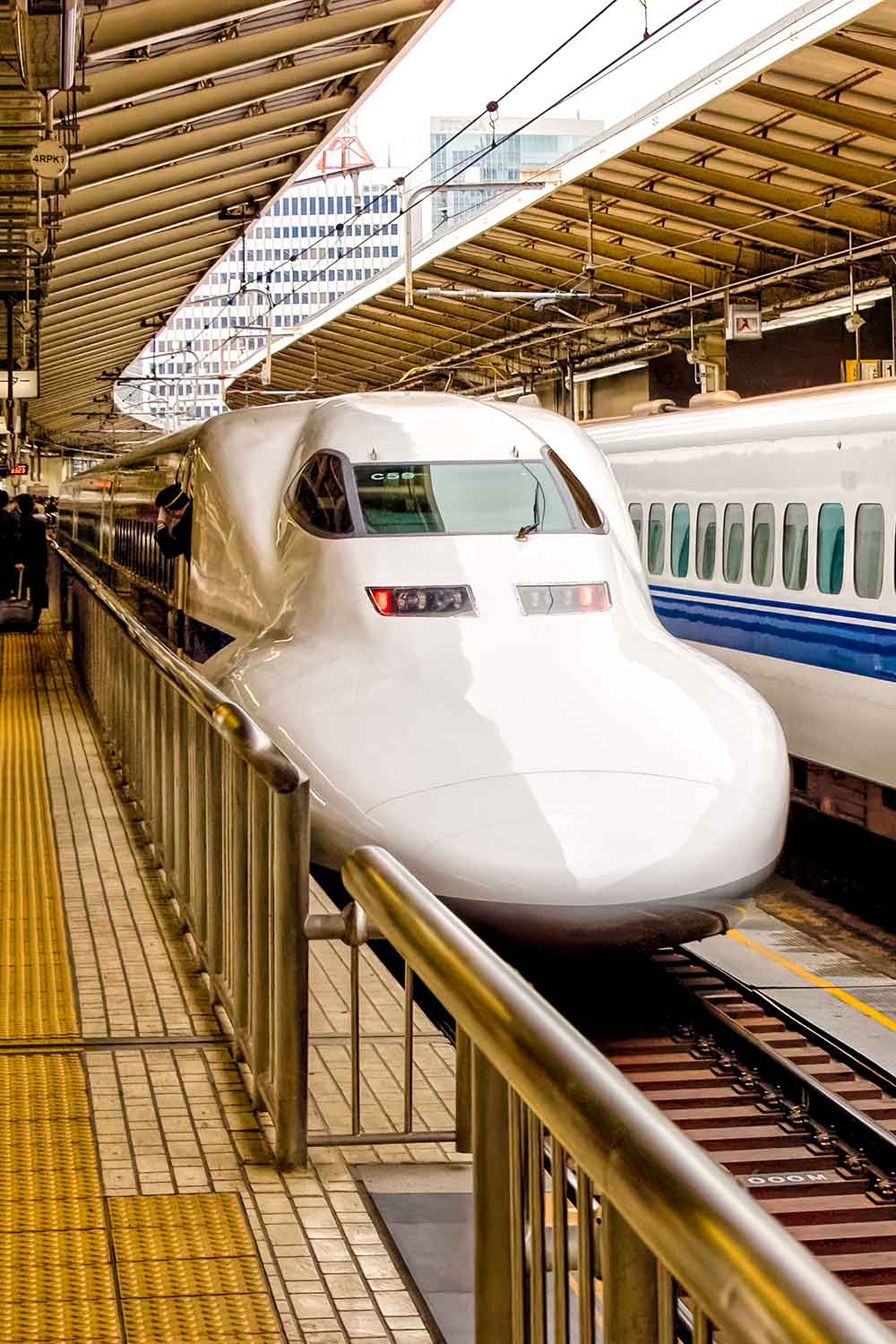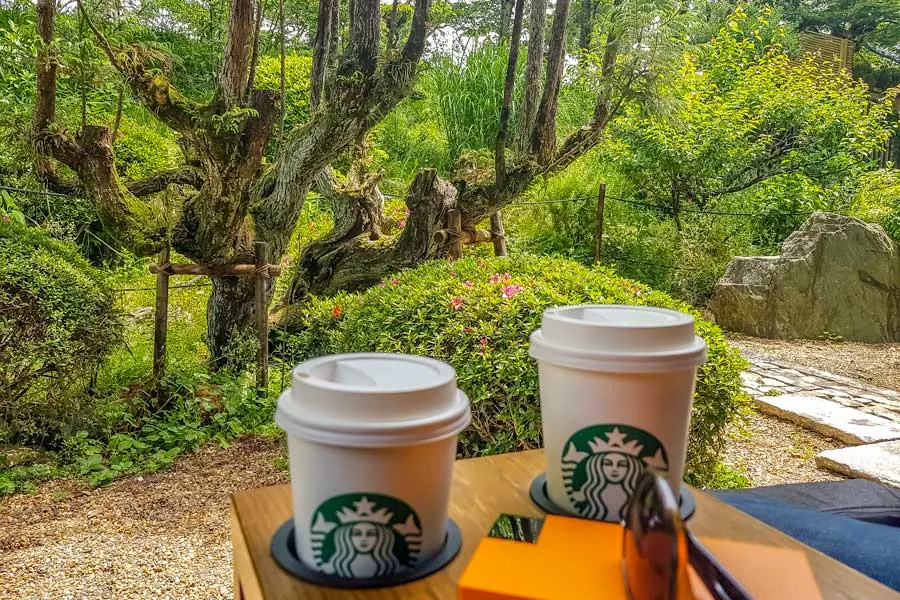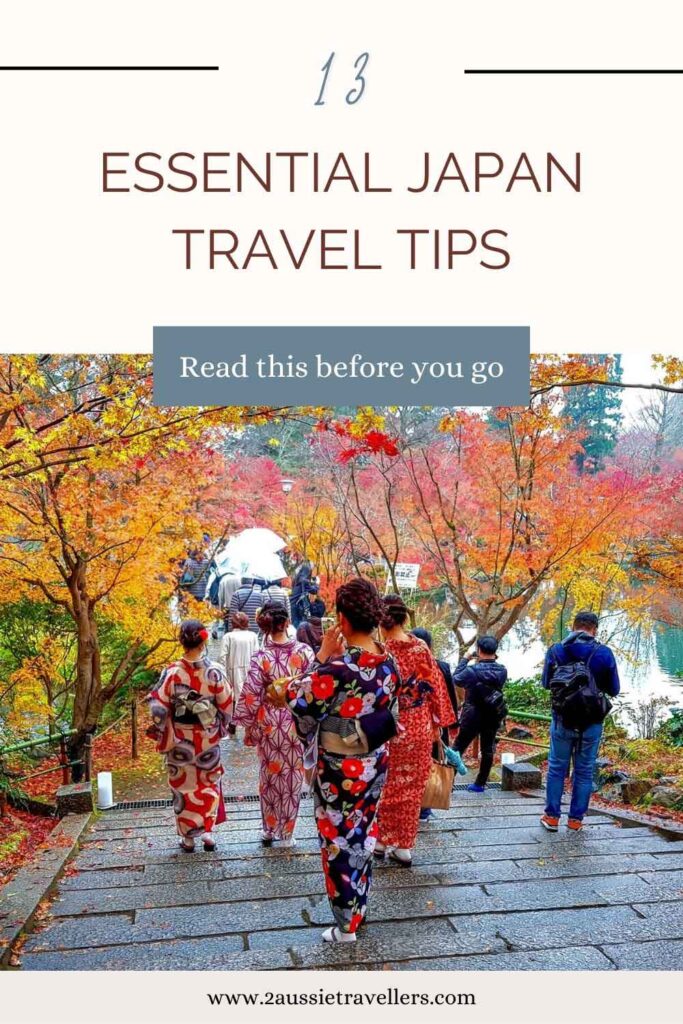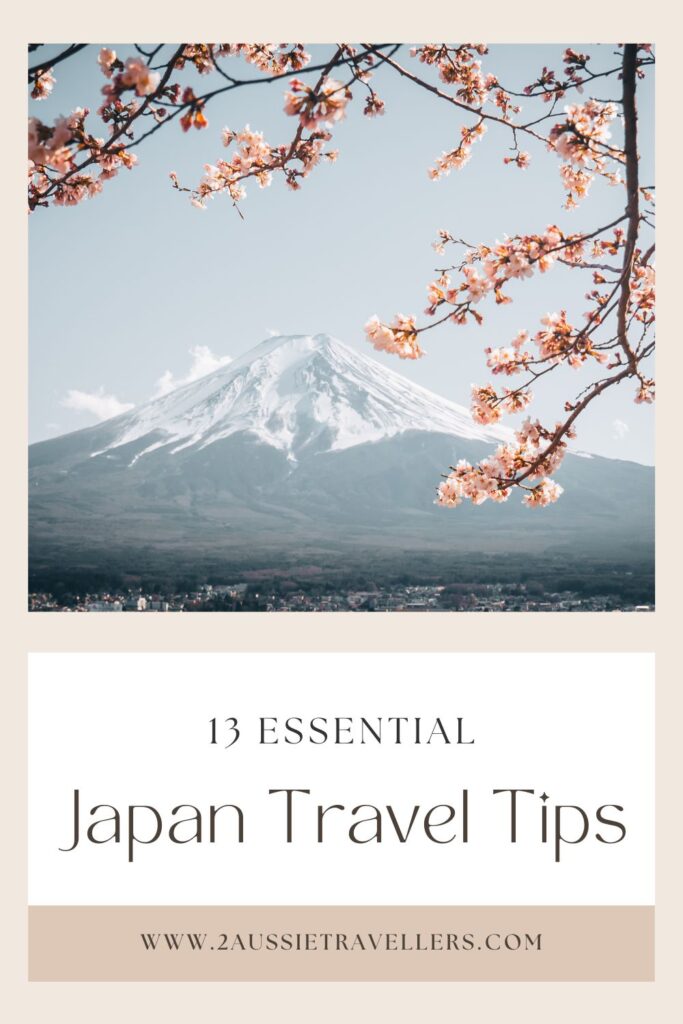Japan is a fascinating country to visit and more foreigners than ever before are planning a visit. One of the big attractions is that it’s so different from many places they’ve been before; the language, food and culture are uniquely Japan and that experience alone is a great reason to visit. With this in mind, we have put together our top 15 Japan travel tips to get you off to a good start.
Understanding a few of these differences early in the planning stage for your trip and some of the opportunities they present is well worth doing. It can ensure you get the best possible experience and maximise the value you get from your travel dollar. There’s a widely held belief that Japan is a very expensive country to visit but that doesn’t have to be the case. Although it can’t be done on the same sort of budget that many countries in South East Asia can we find it no more expensive than travelling in Australia and in many aspects can offer some great value.
We’ve been fortunate enough to travel to the country many times in the past 9 years and are regularly asked for our top tips. In this article, I’ve put together the ones that are most useful as you get underway in the planning process. I’ve linked up related resources to delve more deeply and if you have any questions please ask in the comments section below.
Table of Contents
- The Japan travel tips you won’t want to leave home without
- 1. Decide whether you need the Japan Rail Pass
- 2. Do some planning before you land
- 3. Consider making use of multi-city flights
- 4. Cash is still king
- 5. Staying connected – WIFI in Japan
- 6. Deciding where to go
- 7. What to pack
- 8. Choosing and booking accommodation
- 9. Pick up an IC Card
- 10. You don’t tip in Japan
- 11. Forget everything you know about convenience stores
- 12. Using the Public Toilets
- 13. Don’t overpack – laundry and laundromats
The Japan travel tips you won’t want to leave home without
1. Decide whether you need the Japan Rail Pass
We’ve heard so many stories from friends and through this website of disappointment around the JR Pass and it goes both ways. We hear from those who didn’t know about it in time to take advantage of what can be an amazing saving and others that purchased it on the basis of hearing how fabulous it is but didn’t have an itinerary that suited it. Either way, you can end up paying far more than you need to and we all want to get the best value from our travel spend.
We now hear stories weekly and it prompted us to publish our guide on everything you need to know about the Japan Rail Pass – including when NOT to buy it.

It’s also been announced that the price will increase by around 70% in October 2023. If you are travelling after that date you will want to read this JR pass pricing and value update.
I won’t repeat it all here but I highly suggest anyone travelling to Japan takes a look into whether the pass is worthwhile for them early in their planning process. Often you’ll be able to rule it in or out very quickly but sometimes a small tweak such as the order of destinations can make a significant difference.
2. Do some planning before you land
In many places, I’m happy to work out what I want to see and do once I land in the country. With not speaking the language and many of the things that we might want to see and do being widely spread out, even within the major cities, it’s worth having a fair idea of your plans and priorities ahead of arriving in Japan.
Planning will help you make a decision on the need for rail passes as we touched on above, work out whether you are better suited to basing in one or two cities and taking day trips from there or doing a touring style holiday and moving on every couple of days. It will help you balance seeing as much as possible with still feeling relaxed and enjoying everything you do.
3. Consider making use of multi-city flights
Multi-city flights are where you fly into one city and out of another. We have used this option several times now when flying to Japan and it’s well worth thinking about. It can save time not needing to backtrack to the city you started in and as a result, it can also save you money too.
One of the most popular itineraries for first-time travellers in Japan is what is known as the Golden Route, from Kyoto (0r Osaka) in the west through to Tokyo, Flying into Kansai Airport in Osaka and out from Tokyo can be a great option.
4. Cash is still king
Despite its advanced technology in most things, Japan has remained a cash-based society. We carry a lot more cash when travelling in Japan than we would at home where most things are paid by card or by tapping the phone. We’ve never had an issue with it, Japan is very safe in regards to personal safety and property but I’d still recommend taking reasonable precautions.
With the Rugby World Cup and then the Olympics preparation, we’ve noticed that credit cards are now far more commonly accepted by retailers and the hospitality industry than on our earlier trips. In the past, we really only used them in the hotel and major department stores but I’ve noticed on the last couple of trips there were credit card signs welcoming them in places like taxis, train stations, smaller izakaya, family-owned restaurants and stores.
You can easily get cash out from money machines using your EFTPOS card from home in convenience stores and at Post Offices. There’s no need to get a pre-loaded foreign cash card or traveller’s cheques. The machines will usually charge a small fixed fee per transaction that is disclosed on the machine up front other charges will depend on your own bank. In Australia, you can shop around and find a bank that doesn’t charge any fees on overseas withdrawals which I found worth doing as we travel regularly and you can also find credit cards with no international transaction fees.
5. Staying connected – WIFI in Japan
One of our biggest tips for travelling in Japan is to get a pocket WIFI or mobile data connection on your phone. There is public wifi around and if all you need is to send an email from your hotel at night and post to Instagram at major tourist spots you will be fine however public networks do always pose a data security risk and we find it very useful to have connectivity on demand throughout the day as several apps will make travelling in Japan that little bit easier.

We use both Google Maps and Hyperdia (the website which is now mobile optimised not the app) regularly. These get you where you are going easily including the various public transport options. Often you need to change lines or even railway company during the journey anything to make that smoother is great. Google Translate is also helpful in the camera mode to read signs, packaging and menus.
A local in Osaka also put us onto the VOICETRA app which was amazing. You download and set the language it is going from and to, speak into the microphone or have the other person and it translates it by voice and text. I know Google Translate has been doing something similar for a while but this really works and is pretty accurate. It enabled us to have a reasonable conversation that would have been impossible otherwise.
We discuss in detail the pocket wifi options for Japan in this article.
6. Deciding where to go
The most obvious choices are Tokyo, Kyoto and Osaka which are Japan’s 3 best-known cities. We love spending time in all three but it’s well worth considering an excursion or two off the main tourist trail. This might be something further afield such as Aomori, Kanazawa, Sapporo and Hiroshima, or some of the easily accessed day trips from the major cities, we have some great suggestions from both Kyoto/Osaka and Tokyo.
By heading to some of these destinations you’ll experience a Japan that is very different from the cities. Although a small country only around 25% of Japan is usable space, that is either populated or used for agriculture, the remainder is forests and mountains so there is 75% of the country where you can pretty much get away from it all.
Some great Japanese experiences to add variety to your itinerary are hiking, soaking in an onsen and staying in a ryokan. For a bit of inspiration here are a couple of articles that might provide some inspiration:
- Staying in a ryokan in Kinugawa Onsen (Nikko),
- relaxing away your worries in a natural hot spring (Hakone), and
- some light hiking options in Enryukuji, Mt Takao, Mt Misen and Mt Nokogiri
7. What to pack
While there is a lot to be said in favour of travelling light, it’s not my top priority when travelling in Japan. The average Japanese and the average Westerner are generally quite different in build. That makes buying clothes or shoes challenging and while it might be fun to keep an eye out for a special piece to take home, feeling pressure to shop for something you need because you are now cold / hot / forgot to pack it, isn’t ideal for most.
In Japan shoes are a big consideration when I’m packing. I know I will walk a lot, far more than I do on an average day at home so I want shoes that I have worn enough to know they are comfortable, fairly easy to get on and off, and will stand up to the weather, fabric and suede that you don’t want to get wet aren’t good options.
Read more: ALL of our essential Japan packing tips.
8. Choosing and booking accommodation
I like to have my accommodation booked well in advance for most trips. There are a variety of advantages to this, it means I have already done some preplanning on what I want to be based close to and ensured there are good transport connections nearby. You will generally get the best deals several months, and up to 6 months in advance plus if you are travelling at a popular time you may not be able to get into your first choices if you leave it too close to your travel date.
To offset the risk of plans changing, which we’ve all learned in the last few years can be completely out of our control, I use an online booking site that offers no deposit and free cancellation on most properties.
9. Pick up an IC Card
An IC Card is a stored value card for local transport, the main ones you’ll come across are PASMO, SUICA and ICOCA but there are many others around the country. They’re each offered by different train companies but it doesn’t matter which one you buy, they can all be used on trains, subways and buses around the country.
The only real difference in deciding which to get is that there’s a small deposit, usually Y500 when you pick one up which you can get refunded at the end of your trip by returning the card but you can only do that in the region where it was issued, so for example PASMO in Tokyo or ICOCA in Osaka. Our experience is that it’s well worth it for the convenience of tapping on and off without fussing with individual tickets we just manage the reloading later in our trip to ensure we don’t leave with a large balance outstanding.
In addition to transport, you can also use your IC Cards on some vending machines to buy drinks or at convenience stores known as Konbini in Japan. This can be quite useful if you are picking up things regularly as Japan’s 8% tax means you end up with a lot of Y1 and Y5 coins in your purse that aren’t easy to get rid of.
10. You don’t tip in Japan
Tipping isn’t part of Japanese culture. Rather than being seen as generous, a tip can cause confusion or even be insulting. Respect the local culture and follow local customs rather than inserting your own even if it feels a bit uncomfortable.
The exception is the custom of a ‘seating fee’ that you will find at some restaurants and izakaya. This is usually in the form of a small dish you didn’t order but have to pay for. It’s not much and they are often quite tasty.
If you use the services of a free guide or someone goes out of their way to help you a small gift such as a food or consumable item from your home country is appreciated, I took notebooks with our city on the cover one year that worked well and were easy to carry around. Do keep it small though or people will feel the need to reciprocate.
11. Forget everything you know about convenience stores
Unless you’re on a super limited budget you don’t want to limit yourself to eating at the 7-Eleven, Lawsons and Family Mart but you do want to take a look and try some of the dishes and snacks. Forget any experiences you have from home about convenience store food. In Japan, there’s no issue with food hygiene or sitting too long under heat lamps, due to its popularity it sells quickly and what is on the shelves is freshly delivered daily.
This does offer an opportunity for anyone looking for a bit of a bargain, in the early evening in supermarkets and at night in the convenience stores, there is often food sold at a discount.
Some of the things worth trying from the convenience stores are:
- Onigiri. Our top picks are the spicy cod roe, prawn and mayo, salmon pieces and salmon eggs (ikura).
- Bakery selection. The Japanese preference for bread being sweet does take some getting used to but it is super soft and delicious. Well worth giving a few of these a try.
- Sunscreen. I now bring home 6-8 packets of the Biore Watery Essence 50+ face sunscreen every time I’m in Japan, it’s available at pretty much every convenience store and for me, this is better than all the high-end makeup brand sunscreens I have tried over the years (except Shiseido) but at a fraction of the price.
- Mochi ice cream. This one is Lawsons specific but in the freezer section there are packets of 2 ice cream balls wrapped in a thin soft mochi skin, it’s delicious and as you can no longer buy mochi-cremes at every Shinkansen station this is my new best option. (Yes it has been 10 years now, I promise I will get over them disappearing soon)
- Bottles of drink are generally slightly cheaper in the 7-eleven than the vending machines but you will also find an excellent selection of alcoholic options. The flavoured waters in Japan are great too if you need a bit of encouragement to keep your hydration up, the peach or lychee ones are especially good.
- Snacks. If like us you take longer day trips by train then a few snacks along the way can be good, there is a huge range of unique options to try so we usually just pick out a few that look interesting even if we can’t make out what they are. Most of the time it turns out well.
12. Using the Public Toilets
Japan is the land of contrast and that goes for the bathrooms too. You’ll typically find either a squat toilet or a high-end, ultra-clean automated toilet bowl with a variety of additional functions from a bidet to a heated seat and tunes that mask the sound of you peeing.
The one thing that we have frequently found missing from a Japanese public bathroom was a way to dry your hands. I still suggest carrying a small towel for this, especially in the colder seasons when wet hands will get chapped and sore very easily. We noticed recently hand dryers are appearing more frequently although they generally aren’t the supersonic Dyson dryers you might expect to match with the fancy loo.
Bathrooms have been among my most surprising (both positive and negative) experiences in Japan. The ultra-modern washrooms in a stationery store called Itoya in Ginza definitely stand out. As a stationery nerd, I love this store for many reasons but you really do need to head to the bathrooms. As you enter birds start chirping as if you are in the midst of the forest. The toilet bowl is thoroughly cleansed in blue light before and after you use it, the basins and benches are drip-free and the hand dryer gives your hands a thorough blue light cleansing. Just a word of warning, if you love stationery you will spend a good amount in this store, it’s multi-story and continues on the other side of the road.
The memorable for a less positive reason was using a squat toilet on a long-distance limited express train while it was moving. When your balance isn’t great this is a challenge although it was almost 10 years ago now and I’d be surprised if all long-distance trains don’t offer a Western toilet option now.
While quite a few public restrooms still offer the choice of the two styles there are more Western style than traditional. In the women’s queue anyway, most women under 40 will prefer to wait for them to be available rather than use the more traditional option.
13. Don’t overpack – laundry and laundromats
I know that I mentioned above that I am not a ‘hand luggage only’ traveller in Japan, who am I kidding, I rarely manage that for a weekend away but I also try to take the minimum reasonable amount to get me through.
You don’t need 3 weeks, or even really one week’s worth of clothes. Even if you don’t want to use the hotel laundry and dry cleaning service, as these can get quite expensive, many hotels have a guest laundry that you are able to use at a reasonable cost. There are also laundrymats in many areas you can make use of if necessary, I just prefer the convenience of having it onsite.
A hotel guest laundry or an aparthotel with a washing machine is now one of my criteria when selecting hotels for travelling in Japan. I don’t need it at every hotel but I try to make sure every 3-4 nights we’ll have somewhere I can put a load through. If you are conscious of your travel budget or just have other things you’d prefer to spend your money on this can be a significant saving over either excess baggage or hotel laundry service with minimal impact on your trip.
If you found this article useful please consider saving it to Pinterest. It makes it easy for you to find it again, it helps us, and it helps other travellers to find the information they are looking for.

